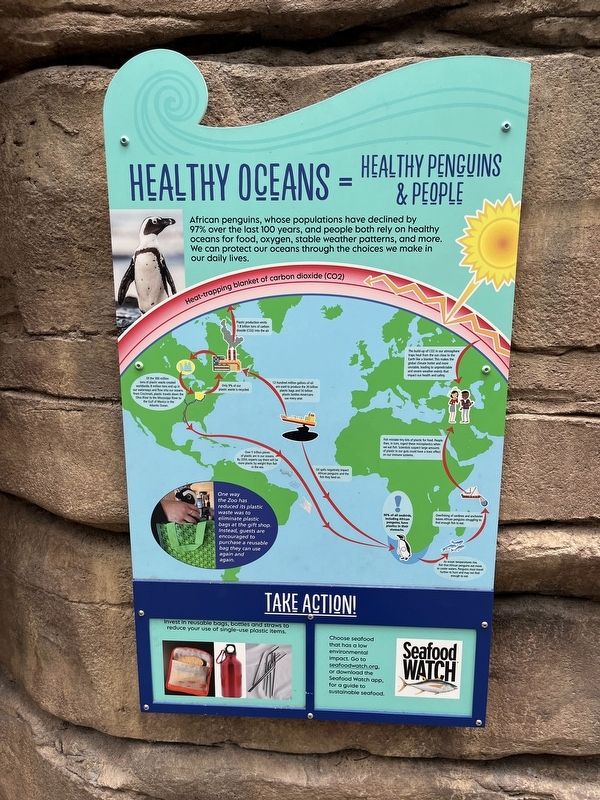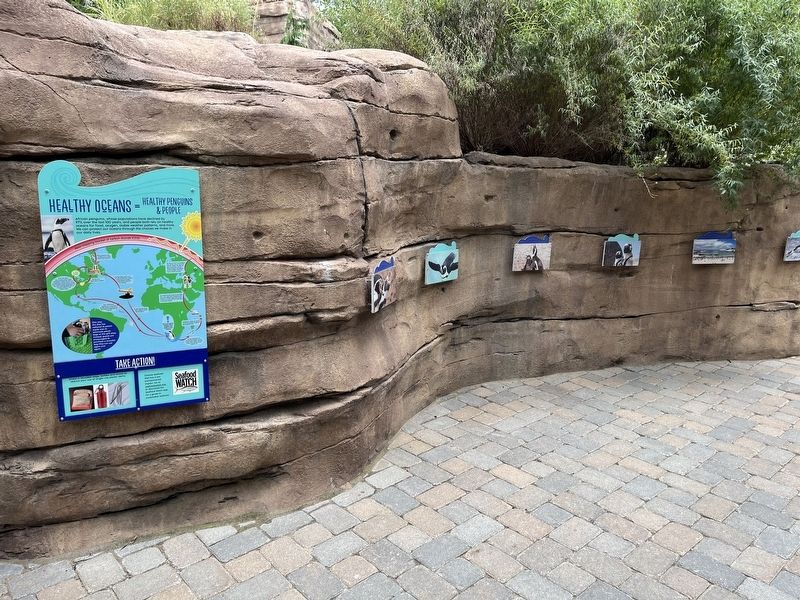Avondale in Cincinnati in Hamilton County, Ohio — The American Midwest (Great Lakes)
Healthy Oceans = Healthy Penguins & People

Photographed By Devry Becker Jones (CC0), June 26, 2022
1. Healthy Oceans = Healthy Penguins & People Marker
African penguins, whose populations have declined by 97% over the last 100 years, and people both rely on healthy oceans for food, oxygen, stable weather patterns, and more. We can protect our oceans through the choices we make in our daily lives.
[Captions:]
Heat-trapping blanket of carbon dioxide (CO2)
Of the 300 million tons of plastic waste created worldwide, 8 million tons end up in our waterways and flow into our oceans. From Cincinnati, plastic travels down the Ohio River to the Mississippi River to the Gulf of Mexico in the Atlantic Ocean.
Only 9% of our plastic waste is recycled.
Plastic production emits 1.8 billion tons of carbon dioxide (CO2) into the air.
Over 5 trillion pieces of plastic are in our oceans. By 2050, experts say there will be more plastic by weight than fish in the sea.
12 hundred million gallons of oil are used to produce the 30 billion plastic bags and 50 billion plastic bottles Americans use every year.
Oil spills negatively impact African penguins and the fish they feed on.
90% of all seabirds, including African penguins, have plastics in their stomachs.
As ocean temperatures rise, fish that African penguins eat move to cooler waters. Penguins must travel further to hunt and may not find enough to eat.
Overfishing of sardines and anchovies leave African penguins struggling to find enough fish to eat.
Fish mistake tiny bits of plastic for food. People, then, in turn, ingest these microplastics when we eat fish. Scientists suspect large amounts of plastic in our gust could have a toxic effect on our immune systems.
The build-up of CO2 in our atmosphere traps heat from the sun close to the Earth like a blanket. This makes the global climate hotter and more unstable, leading to unpredictable and severe weather events that impact our health and safety.
One way the Zoo has reduced its plastic waste was to eliminate plastic bags at the gift shop. Instead, guests are encouraged to purchase a reusable bag they can use again and again.
Choose seafood that has a low environmental impact. Go to seafoodwatch.org, or download the Seafood Watch app, for a guide to sustainable seafood.
Erected by Cincinnati Zoo and Botanical Garden.
Topics. This historical marker is listed in these topic lists: Animals • Environment

Photographed By Devry Becker Jones (CC0), June 26, 2022
2. Healthy Oceans = Healthy Penguins & People Marker
Location. 39° 8.719′ N, 84° 30.444′ W. Marker is in Cincinnati, Ohio, in Hamilton County. It is in Avondale. Marker can be reached from Vine Street north of Erkenbrecher Avenue, on the right when traveling north. Touch for map. Marker is at or near this postal address: 3400 Vine St, Cincinnati OH 45220, United States of America. Touch for directions.
Other nearby markers. At least 8 other markers are within walking distance of this marker. Mexican Wolf (within shouting distance of this marker); Meet AP063 (within shouting distance of this marker); A Fierce Green Fire (within shouting distance of this marker); Centuries of Wildlife in Ohio (within shouting distance of this marker); Gray Fox (within shouting distance of this marker); Salmon-Crested Cockatoo (within shouting distance of this marker); The River Otter's Return (within shouting distance of this marker); Garden of Peace (within shouting distance of this marker). Touch for a list and map of all markers in Cincinnati.
Additional commentary.
1. About the Marker
This marker qualifies for inclusion in the database because it explains how human activity has affected the environment in the past century.
— Submitted July 2, 2022, by Devry Becker Jones of Washington, District of Columbia.
Credits. This page was last revised on February 4, 2023. It was originally submitted on July 2, 2022, by Devry Becker Jones of Washington, District of Columbia. This page has been viewed 109 times since then and 6 times this year. Photos: 1, 2. submitted on July 2, 2022, by Devry Becker Jones of Washington, District of Columbia.